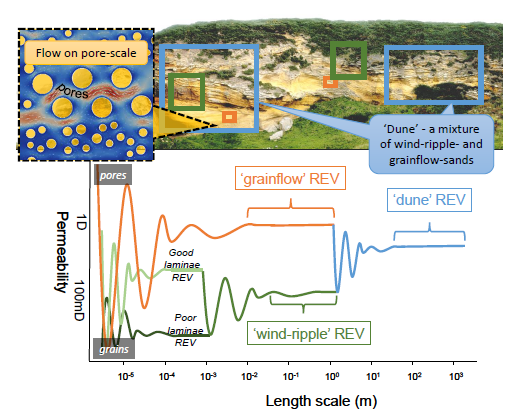Multiscale analysis of selected problems in fluid dynamics, 2017
Sergey Alyaev
Hovedinnhold
Advisors: Jan Martin Nordbotten and Eirik Keilegavlen
Short description of project:
The world around us is inherently multiscale. The variety of different models depending on the reference scale is particularly diverse in problems of fluid-solid systems. For those systems, the geometry, effective parameters and even equations vary between scales. Normally, on coarser scales the fundamental laws of physics are not sufficient to provide a closed-form model. This called for experiment-based closures, which often had limited domain of applicability. An alternative approach enabled by recent developments is so-called multiscale methods. By considering the two scales simultaneously, multiscale methods do not rely on experimental closures and therefore lay a physics-based foundation for engineering problems.
In this work, we attempt to separate multiscale methods into larger classes based on a flowchart that contains questions about the structure of problems, for which they are designed. Analysis and methods, presented in the thesis, aim to fill the gaps in inter-disciplinary knowledge across several classes of multiscale methods. We conduct fit-for-purpose analysis of several selected multiscale problems in fluid dynamics: nonlinear single phase flows in porous media, fractal structures formation in freezing brine, particle-particle interaction affected by capillary bridging.
The first problem is addressed by the control volume heterogeneous multiscale method (CVHMM). By coupling mass conservation with Navier-Stokes equations on the pore scale, the method captures nontrivial coarse-scale effects, which are not handled by standard single-scale models. To demonstrate the robustness of the presented methods, a multiscale convergence analysis and a derivation of a priori error estimates are developed for the method.
For the second problem, simplifications and consequent self-similar analysis identifies compact and fractal regimes of ice formation. Moreover, combining the insights obtained from numerical and analytical solutions we introduce an empirical model that can qualitatively predict properties of the formed ice.
For the third problem, we derive a new semi-analytical solution for particle interactions during viscous bridging. The solution provides basis for more efficient simulation of suspended flows of particles.
Link to thesis at BORA-UiB: http://bora.uib.no/handle/1956/15563
